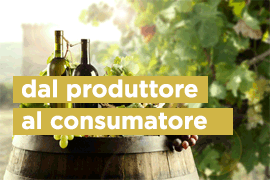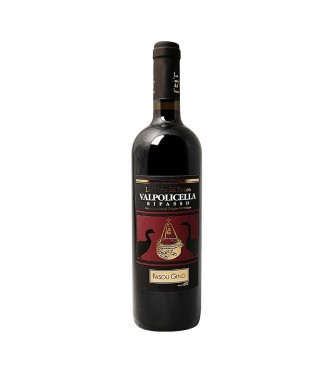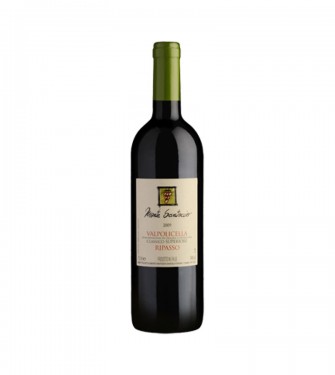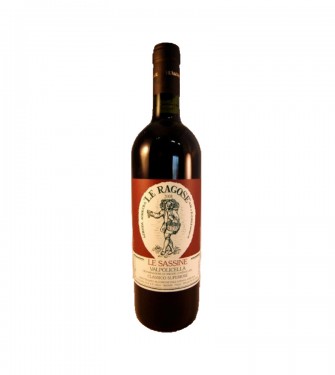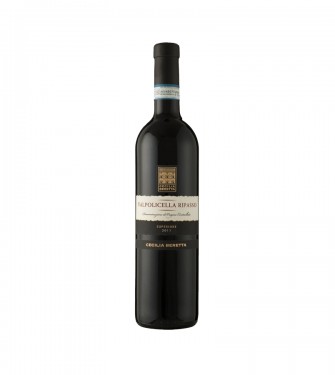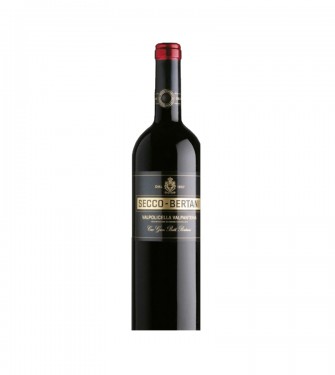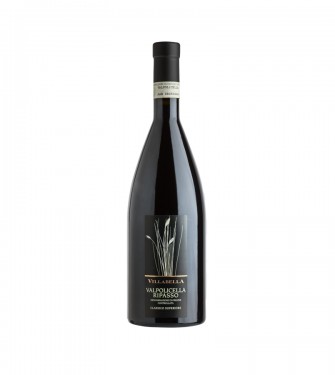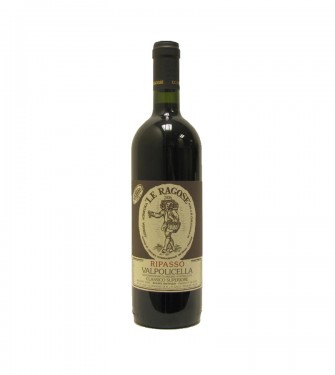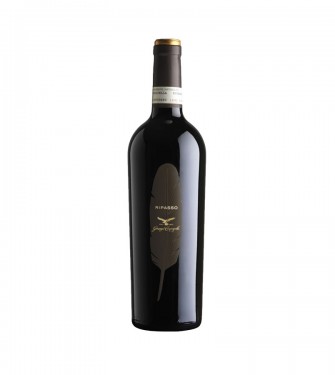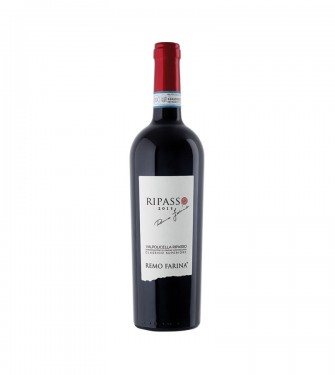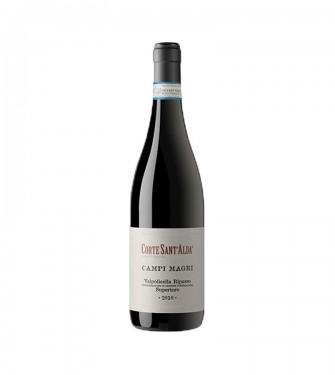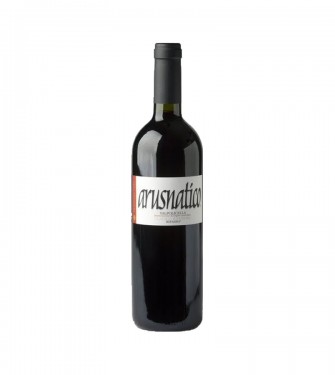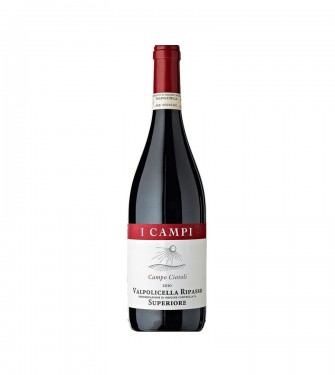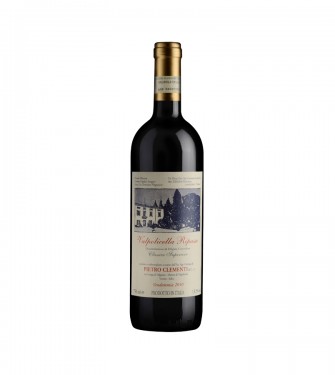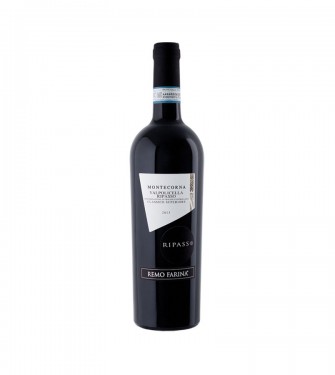Valpolicella Ripasso DOC WINES
-
Prezzo di listino: € 19,67Special Price € 16,39 -17%
-
Prezzo di listino: € 20,99Special Price € 17,49 -17%
-
-
-
-
Prezzo di listino: € 19,85Special Price € 14,00 -29%
-
Prezzo di listino: € 18,03Special Price € 16,23 -10%
-
Prezzo di listino: € 18,35Special Price € 15,29 -17%
-
-
Prezzo di listino: € 30,23Special Price € 25,19 -17%
-
Prezzo di listino: € 20,99Special Price € 20,79 -1%
-
-
-
Valpolicella Ripasso DOC WINE
Valpolicella Ripasso DOC is obtained by the contact of the Valpolicella wine to the residual Amarone’s marcs for about 15-20 days. Compared to Valpolicella basic wine it is characterized by a greater and longevity structure, by a higher alcohol content, lower acidity and higher roundness.
It has a garnet ruby red color, the perfume is slightly ethereal with pink fruit and notes of vanilla; a refined flavor, well balanced, dry and velvety. Due to its characteristics of pleasantness, it is excellent for early winter dishes, main dishes, cold cuts and medium-aged cheeses.
UN EXCELLENT WINE BETWEEN ITALIAN RED WINES: THE VALPOLICELLA RIPASSO DOC
Valpolicella Ripasso DOC is a red wine produced in Veneto, precisely in Valpolicella, near Verona.
This particularly and eclectic wine stands out compared to the Valpolicella Classico wine because it is obtained through a very particular method: the method of Ripasso.
This wine has its own spirit with a peculiar character, it is not as many describe it simply a version of Amarone, but it is a young and unique product, a large Italian public appreciates the features and the unmistakable aroma. Loved by the entire nation for its excellent value for quality and price, this wine is the summary of the tradition and quality of enology from Verona, a source of pride for the country which in recent years has received more and more interesting requests to export this product.
The story of this wine and of the territory where it was born is a long history made of rows of vines, passion, and great competence. His fame competes, and sometimes exceeds, with Amarone Valpolicella wine that this young wine owns its fame. On the lands of Valpolicella, meanwhile, the fertile cultivation and the production continues in these vineyards.
THE METHOD OF RIPASSO, THE SECRET OF THE VALPOLICELLA RIPASSO DOC
The most peculiar technique in the production of Valpolicella Ripasso DOC is precisely the Ripasso. The method of wine-established tradition does not seem to be never been known or used outside the region of Veneto.
The production of Valpolicella Ripasso DOC consists in macerating Valpolicella wine with fermented marcs of dried grapes just used for the production of other two famous local wines, Amarone and Recioto.
Once the marcs have been dripped, then they are put in contact with the wine Valpolicella for some time. The result is not always the same, since it depends on the types of marcs used, on the quality of the fresh wine, on the time of the contact and other variables.
Normally they avoid the maceration times too long to avoid mixings of tannins, while maintaining contact with a bitter product, developments an excessive dryness which confers a heavy tone to the final product.
The combinations that can be obtained are quite varied: for Ripasso you can only use tmarcs of Recioto, like for the production of Valpolicella Superiore Ripasso, or just Amarone, and it is the case of the Valpolicella Classico Superiore, or both. The contact with Valpolicella and marcs can last a few days or even a decade and more. Some winegrower finally decided to enrich the wine by adding dried grapes.
Depending on the versions we can have the Valpolicella Ripasso Classico, produced in the municipalities of Negrar, Marano di Valpolicella, Fumane and others in the region so-called Classical; Valpolicella Valpantena, produced in the valley; and finally the Valpolicella Superiore Ripasso, with aging in barrels for one year and a minimum alcohol content greater than 12%.
THE HISTORY OF VALPOLICELLA RIPASSO
Valpolicella Ripasso is a wine of very ancient tradition and rooted in the territory. We received testimonials that the ancestor of this wine, called Retico, was praised and applauded by many Roman historians. Retico can be considered the ancestor of all the wines produced today in Valpolicella.
The first traces of wine Valpolicella Ripasso begin when it is conceptualized for the first time this particular method of production. Ripasso, as will be seen, is a very old and well-established winemaking technology, long appreciated by the winemakers from Valpolicella.
The first traces of this method dates back to the Middle Ages, under certain agreements between who marketed the wine and who produced it. Other historical testimonials track the presence of Valpolicella Ripasso in trade with the Republic of Venice. In particular, during this period, this wine was seen as a noble product and intended to richer diners.
The historical memories of the region of Veneto have many rich testimonies that bear the name of this wine, patiently collected over the time by the Società Enologica Veronese.
Around the year 1800, with the introduction of new agricultural machinery, the production techniques of this wine were improved to the point that the product was presented at the Universal Exhibition of Vienna. This wine was decanted during the twentieth century by poets, critics and sommeliers and it becomes increasingly known even outside of the Verona area. In 1960 the company patented a new method of production Valpolicella Ripasso. In 1968 the specification was drafted and the Valpolicella Ripasso gets the name DOC: are established all the techniques of production and the geographical area in which are permitted the winemaking operations.
In 2010, to protect different types of Valpolicella, through some ministerial decrees Valpolicella, Ripasso, Amarone della Valpolicella and Recioto della Valpolicella were differentiated, all wines that are produced within the same territory but with different processes.
Meanwhile the Valpolicella Ripasso is the subject of more and more specific attention from wine magazines such as Gambero Rosso and Touring Club, getting a feedback increasingly broad and solid.
THE WINE VARIETAL OF VALPOLICELLA
For the production of Valpolicella Ripasso DOC, as described in the specification, you must use the native grape varieties, namely the Corvina Veronese (also called Cruina), for a minimum of 45% and a maximum of 95%, a percentage for the Rondinella between 5% and 30%, and up to 25% other non-aromatic red grapes of the province of Verona.
The Corvina Veronese grape variety is a plant sufficiently robust and resistant, with a pentagonal leaf, with a cluster of cylindrical medium sized and berries with medium size and with color between dark blue and black. This wine ages between the end of September and the first days of October, and is at ease on alluvial soils, hilly and well exposed to the wind. It gives to the wine a characteristic tone with fruity aroma.
The vine named Rondinella is very resistant to cold and fits well on any terrain. It develops a pentagonal leaf with a medium size with berries enough round and with a color between black and purple.
The vine named Molinara is more sensitive to cold temperatures. It has an elongated leaf with medium size, a cylindrical cluster, berries that fade between red and purple. The Molinara gives to the Valpolicella Ripasso DOC a tone of acidity that well balances the aroma. Among the red grapes complementary vines more used we can mention the Croatina, widespread since the nineteenth century. It is equipped with small and extended leaves with a big bunch of dark blue berries. It prefers deep and fertile soils.
THE TERRITORY: VALPOLICELLA, THE VALLEY OF VERONESE WINES
Valpolicella is known as one of the more fertile lands of northern Italy, and as one of the favorite areas for the production of wine. Its name means Valley of the many wineries (from the Greek polis and Latin cellae). This magnificent land is very rich in history and culture, it has beautiful scenery and it offers numerous types of wines.
In a natural environment made up of vineyards, plowed fields, hills and small rural villages, the "garden of Verona" makes loved fruits. It has been inhabited since pre-Roman times from the population Rhaetian, and before that since prehistoric times, the Valpolicella brings lots of historical testimonials of the Christian era, and large estates owned by the nobility of the aristocratic families. Valpolicella extends in the north-west of Verona, with its valleys, framed by Monti Lessini and from the warm winds coming from Lake Garda. In these areas there are five commons where vineyards are cultivated: Sant'Ambrogio, Marano, Negrar, Fumane and San Pietro in Cariano.
This area creates famous and renowned wines such as Amarone di Valpolicella and, of course, the Valpolicella Ripasso.
ANALYSIS OF VALPOLICELLA RIPASSO DOC
When you see Valpolicella Ripasso DOC
Valpolicella Ripasso DOC is an intense ruby red wine, tending to garnet as it ages.
When you smell Valpolicella Ripasso DOC
The aroma of this wine from Verona is distinctive, pleasant and well-structured, with fruity notes.
When you drink Valpolicella Ripasso DOC
This wine has a full, velvety, full-bodied and very quaint flavor. The soft tannins, the notes of red berry and the soft fruit and vanilla make its distinctive aroma.
The aging of Valpolicella Ripasso DOC
This wine is aged for at least one year before being sold. It is left usually for 16-18 months in steel tanks and six months for the aging in bottle. This wine gives a good result even after eight or ten years of aging.
SERVICE TEMPERATURE AND GLASS
The wine should be ripped at least an hour before being served and to be savored in the fullness of its characteristic flavor it must be served at a temperature of 16-18 degrees.
The best glass for serving the Valpolicella Ripasso DOC is the classic large cup of red wine and so you can enjoy many flavors on the palate.
Food dishes to combine with this great wine from the Veronese tradition
This wine has historical tradition and it is perfect to enjoy the Italian cuisine: you can rarely catch a product in a love story that tie him to his country and to the regional cuisine as what happens with this wine from Verona.
In Valpolicella Ripasso DOC wine the intense tones of Amarone come together in a curious mix with those of the classic Valpolicella, creating a wine that is in itself an unique cookery experience in Italy
.
Valpolicella Ripasso DOC is perfect with meat and cheeses dishes, because it is a well-structured red wine and body. It is a fairly versatile wine that goes well with many dishes of the Veronese tradition but also open to different combinations.
Dishes of meat, pasta and other types of recipes such as those based on game (pasta with ragout sauce, venison or wild boar) are perfect to enjoy the full flavor consisting of this wine. Try it with pasta with meat sauce, grilled meat, ravioli, roasts, and in general with all the medium-aged cheeses and hard cheeses.
It is excellent with grilled meat and generally with the most representative dishes of Italian cuisine made of pork. Try it with grilled white meat and stewed. It may well accompany the appetizer when paired with meats and cheeses.


